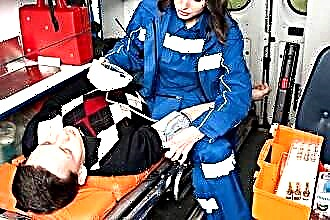Experts all over the world are faced with such pathology as an enlargement of the left atrium every day. Everyone should know about the concept of a disease, the causes and signs by which it can be recognized. It is awareness that will help detect pathology as early as possible and save human life.

Causes of pathology
The myocardium is a muscle that tends to hypertrophy. But if in the case of ordinary muscle tissue it is not dangerous, then with the heart it is the opposite. Left atrial enlargement is a pathological condition that requires treatment.
Hypertrophy can be true or false. The first type is caused by hyperplasia, that is, the multiplication of certain cells. It is the result of high stress on an organ or system. This species also has the name of the worker. Often people who deal with high physical activity are prone to true hypertrophy.
The false type of enlargement consists in the progressive proliferation of fat cells, which leads to this kind of hypertrophy. This form of the disease is most often observed in people with a sedentary lifestyle.
The mechanism of the hypertrophy process is as follows: the human heart has 2 halves (right and left). Each of them is divided into a ventricle and an atrium, which are connected by holes. The lumen of these holes is also equipped with valves. On the left, it has two wings, and on the right, three.
Thanks to them, the heart regulates blood circulation through the systematic reduction and release of portions of blood into nearby vessels. During heavy physical exertion, the oxygen demand of the body's cells increases, as a result of which the heart is obliged to work faster. This requires more muscle tissue, which is formed during such overloads.
Such changes are fraught with consequences, the most unfavorable of which is death. In addition to strenuous physical activity, there are also a large number of factors that can lead to hypertrophy. You need to know them and try to avoid them.
Hypertrophy of any part of the heart can be congenital and acquired. This pathology can affect several heart chambers at once, but the left atrium is more susceptible to this. It is the increase in the size of this department that does not act as a separate disease, but is only a symptom that indicates concomitant pathological processes.
There are many reasons for the increase in the wall thickness of the left atrium. The main ones are:
- being overweight, especially in young people;
- cardiovascular pathology;
- narrowing of the mitral valve in the left atrial cavity;
- high blood pressure;
- insufficiency of the valve apparatus;
- frequent stressful situations and depressive conditions;
- acute renal failure;
- diabetes;
- respiratory diseases;
- constant physical activity;
- playing sports;
- the presence of muscular dystrophies;
- the presence of bad habits;
- severe genetic inheritance.

Narrowing of the mitral valve is a heart defect. Its essence lies in the stenosis of the cleft, which is a connected channel for the atrium and ventricle.
This syndrome is often accompanied by severe insufficiency of this valve, which is characterized by the process of regurgitation. Some of the blood is pumped back from the ventricle into the atrium, and the valve is unable to prevent this.
Sports can also be the cause of this cardiac pathology, if the loads do not match the person's capabilities. With frequent and high voltages, the heart muscle cannot cope with the flow of a large amount of blood; it needs additional strength to push it out. As a result, an increase in the muscle tissue of the heart can be observed as compensation for this process. Before choosing the type and amount of sports loads, you should first go through a consultation with specialists, learn about training and possible modes.
It is very dangerous to ignore heart problems. To protect yourself from possible failures in the work of the main organ, you need to lead a healthy lifestyle, moderately engage in physical activity and sports, and also more often consult doctors for the timely detection of various concomitant diseases.
Hypertrophy symptoms
 In the early stages, there are no pronounced symptoms, while when the process is started, a whole variety of signs can be observed, among which experts distinguish:
In the early stages, there are no pronounced symptoms, while when the process is started, a whole variety of signs can be observed, among which experts distinguish:
- headache;
- pain in the left side of the chest, which can radiate to the back, left arm or neck;
- heart rhythm disturbances;
- pressing pains in the chest;
- sleep disturbances;
- cachexia;
- increased fatigue.
Also, people with hypertrophied left atrium may experience periodic loss of consciousness, which is triggered by a lack of oxygen. The same insufficiency provokes shortness of breath. In the early stages of the disease, it can be observed in patients with sports or heavy physical exertion, while in advanced cases it occurs in a state of complete rest.
Left atrial hypertrophy is dangerous because in the early stages it may not bother a person at all and not cause him discomfort. The patient does not know anything about hypertrophy until it gains significant proportions.
Ignoring these symptoms can lead to serious, irreversible consequences, which can result in death. Therefore, if any signs are found, you need to contact a specialist as soon as possible, because only he can help as effectively as possible.
Consequences and prognosis
Left ventricular hypertrophy can result in impaired blood flow in the systemic circulation, as well as acute heart failure, cardiac arrhythmias, or myocardial infarction. Death is very common.
 Also, among the most common consequences, it is worth highlighting:
Also, among the most common consequences, it is worth highlighting:
- pulmonary edema of different etiology;
- acute renal failure;
- atrial fibrillation.
The prognosis of this disease depends entirely on the cause and stage. Early diagnosis, high-quality treatment and further adherence to preventive measures can give a high chance of a favorable prognosis. In this case, the patient will retain his ability to work and will be able to enjoy a full life.
An increase in the left atrium can be a signal indicating the presence of life-threatening diseases, including various vascular pathologies, heart valve insufficiency, and diabetes mellitus.
In this case, the prognosis depends entirely on the treatment.
Hypertrophic changes should be treated with extreme caution, because any delay, even an elementary inattention to one's health, can gradually worsen the situation. In advanced cases, the chance of full recovery is negligible, because the processes of cardiac asthma and pulmonary edema develop, which can lead to serious problems, and in the worst case, to the death of the patient.
In no case should it be considered that this pathology has extremely unfavorable prognosis. Even with congenital concomitant heart defects, a large number of patients have a high chance of a full life.
Statistics say that one of the major turning points is early diagnosis and prompt treatment. It is in this case that the forecast is most positive. When the first symptoms are found, it is necessary to consult a specialist as soon as possible.Each of the signs can be a wake-up call that indicates a serious pathology that requires immediate treatment.



